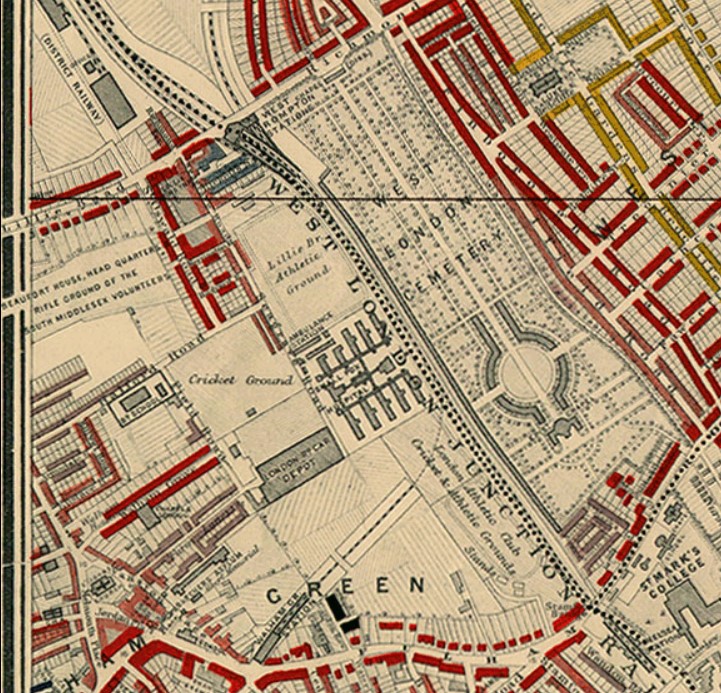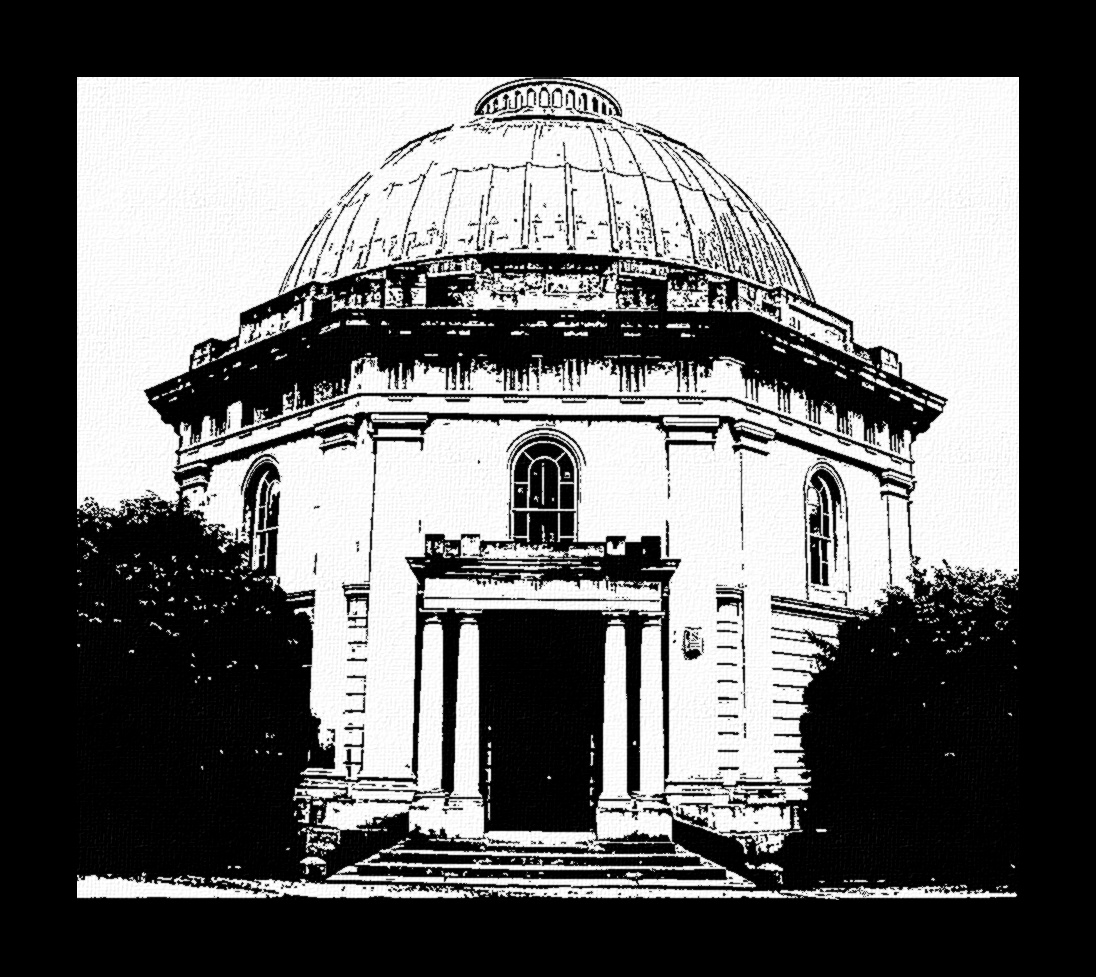Brompton Cemetery
Brompton Cemetery (originally the West of London and Westminster Cemetery) is since 1852 the first (and only) London cemetery to be Crown property, managed by The Royal Parks, in West Brompton in the Royal Borough of Kensington and Chelsea. It is one of the Magnificent Seven cemeteries. Established by Act of Parliament and laid out in 1839, it opened in 1840, originally as the West of London and Westminster Cemetery. Consecrated by Charles James Blomfield, Bishop of London, in June 1840, it is one of Britain's oldest and most distinguished garden cemeteries. Some 35,000 monuments, from simple headstones to substantial mausolea, mark more than 205,000 resting places. The site includes large plots for family mausolea, and common graves where coffins are piled deep into the earth. It also has a small columbarium, and a secluded Garden of Remembrance at the northern end for cremated remains. The cemetery continues to be open for burials. It is also known as an urban haven for nature.
Although the cemetery was originally established by a private company, it is now the property of the Crown.
Contents
Location
Charles Booth 1889 map – detail showing Brompton Cemetery
Brompton Cemetery is adjacent to West Brompton station in west London, England. The main entrance is at North Lodge, Old Brompton Road in West Brompton, SW5, in the Royal Borough of Kensington and Chelsea. There is another entrance at South Lodge, located on the Fulham Road.
History
Brompton Cemetery Chapel
By the early years of the 19th century, inner city burial grounds, mostly churchyards, had long been unable to cope with the number of burials and were seen as a hazard to health and an undignified way to treat the dead. In 1837 a decision was made to lay out a new burial ground in Brompton, London. The moving spirit behind the project was the architect and engineer, Stephen Geary, and it was necessary to form a company in order to get parliamentary permission to raise capital for the purpose. Geary was appointed as architect but was later forced to resign. Securing the land – some 40 acres – from local landowner, Lord Kensington and the Equitable Gas Light Company, as well as raising the money proved an extended challenge. The cemetery became one of seven large, new cemeteries founded by private companies in the mid-19th century (sometimes called the 'Magnificent Seven') forming a ring around the edge of London.
The site, previously market gardens, having been bought with the intervention of John Gunter of Fulham, was 39 acres (160,000 m2) in area. Brompton Cemetery was eventually designed by architect, Benjamin Baud with at its center, a modest sandstone domed chapel dated 1839, at it southern end, reached by two symmetrical long colonnades, now all Grade II* listed, in the style of St. Peter's Square in Rome, and flanked by catacombs. It was intended to give the feel of a large open air cathedral. It is rectangular in shape with the north end pointing to the northwest and the south end to the southeast. It has a central "nave" which runs from Old Brompton Road towards the central colonnade and chapel. During the 4-year restoration project that began in 2014, an original Victorian flooring with Bath and York stone radial pattern was uncovered underneath the chapel carpet.
Below the colonnades are catacombs which were originally conceived as a cheaper alternative burial to having a plot in the grounds of the cemetery. Unfortunately, the catacombs were not a success and only about 500 of the many thousands of places in them were sold. The Metropolitan Interments Act 1850 gave the government powers to purchase commercial cemeteries. The shareholders of the cemetery company were relieved to be able to sell their shares as the cost of building the cemetery had overrun and they had seen little return on their investment and there were few burials at first.
During World War II the cemetery suffered bomb damage.
Burials
Brompton was closed to burials between 1952 and 1996, except for family and Polish interments, of which there are over 300.[17] In the 21st century it is once again a working cemetery, with plots for interments and a 'Garden of Remembrance' for the deposit of cremated remains.[18] Many nationalities and faiths from across the world are represented in the cemetery.
Military graves
From 1854 to 1939, Brompton Cemetery became the London District's Military Cemetery. The Royal Hospital Chelsea purchased a plot in the north west corner where they have a monument in the form of an obelisk; the Brigade of the Guards has its own section south of that. There are 289 Commonwealth service personnel of World War I and 79 of World War II, whose graves are registered and maintained by the Commonwealth War Graves Commission. A number of veterans are listed in the Notable Interments.[19] Although the majority of war graves are in the dedicated railed section to the west – also containing 19th century services graves – a number of servicemen's graves are scattered in other areas. Besides the British there are many notable Czechoslovak, Polish and Russian military burials.
Exhumations
In the late 1880s when the nearby Earl's Court Exhibition Grounds played host to the American Show with Buffalo Bill, a number of Native American performers in the show, died while on tour in Britain. The Sioux chief, Long Wolf, a veteran of the Oglala Sioux wars was buried here on 13 June 1892 having died age 59 of bronchial pneumonia. He shared the grave with a 17-month-old Sioux girl named White Star believed to have fallen from her mother's arms while on horseback. A British woman, Elizabeth Knight, traced his family 105 years later and campaigned with them to have his remains returned to the land of his birth. In 1997, Chief Long Wolf was finally moved to a new plot at Wolf Creek Cemetery (ancestral burial ground of the Oglala Sioux tribe) in Pine Ridge, South Dakota.
His great-grandson John Black Feather said "Back then, they had burials at sea, they did ask his wife if she wanted to take him home and she figured that as soon as they hit the water they would throw him overboard, so that's why they left him here."
There was a Brulé Sioux tribesman buried in Brompton named Paul Eagle Star. His plot was in the same section as Oglala Sioux warrior Surrounded By the Enemy who died in 1887 from a lung infection at age 22. Like Long Wolf, he took part of Buffalo Bill's Wild West Show. Paul died a few days after breaking his ankle when he fell off a horse in August 1891. His casket was exhumed in spring of 1999 by his grandchildren, Moses and Lucy Eagle Star. The reburial took place in Rosebud's Lakota cemetery. Philip James accompanied the repatriation.
Little Chief and Good Robe's 18-month-old son, Red Penny, who traveled in Buffalo Bill's Wild West Show is also buried here. His specific resting place within the cemetery is not known.
Funerary art
The richness of the art and symbolism contained in many graves traces art movements across two centuries. Aside from the stonemason's and sculptor's craft, there is a vast array of lettering, decorative ironwork (sadly in a very corroded state) and ceramics. Some graves and mausolea are the work of noted artists and architects.
Flora and fauna
Although never envisaged as a park, JC Loudon devised the original planting scheme that was not fully realized, however, pines were imported from Poland with the prospect that in maturity they would cast shade over the graves. There are over 60 species of trees, of which the limes are dated to 1838. The fact of the enclosure of the cemetery by a wall, has preserved almost intact, a distinct area of Victorian country flora. The adjacent West London line afforded a green corridor for many years, enriched by ballast from the South Downs when Counter's Creek was filled in and two railway lines constructed in mid-19th century, although a small wetland area was preserved by West Brompton station. However recent redevelopment along the station has further reduced local biodiversity and further reductions are planned with the major redevelopment of nearby Earls Court Exhibition Center.
In the cemetery each season brings its features, like snow-drops and bluebells or wild lupin and foxgloves, broad-leaf pea, ferns and horse tail. There are small scale wooded areas and meadows. Since the land was used for market gardens, there are wild cabbages, asparagus and garlic among the slabs. A grape vine has fallen victim to maintenance. In Autumn, there can be a display of fungi, a mycologist's trove. The evergreens and ivy are a haven for birds and countless insects. Over 200 species of moth and butterfly have been identified in the cemetery. Despite the absence of a permanent water feature, there have been sightings of amphibians, notably a toad. Mammals are represented by bats, a range of rodents, including grey squirrels and one or two families of foxes. Among the birds, there is a long-standing population of carrion crows and several garden species with the addition of green woodpeckers and occasionally, nesting kestrels and ring-necked parakeets. The appearance of a female ring-necked pheasant in 2012 was short-lived.
"Brompton Cemetery has been identified as a Site of Borough Importance for Nature Conservation (grade I) comprising moderately diverse grassland that contains at least three notable London species that support a diverse assemblage of invertebrates".

